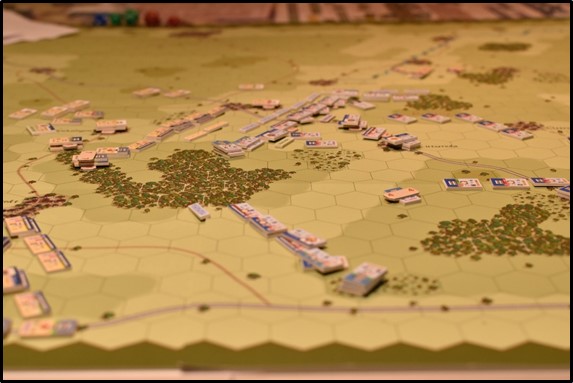10:00 French turn
Ney acted on the new orders he had received, and true to form he immediately lead his light cavalry straight at the larger and heavier Prussian and Saxon horse of Holtzendorf’s detachment. The Prussian and Saxons spurred on their horses and met the charge. Leading the charge, the 10th Chasseurs were met head on by the heavier cavalry of the Prittwitz’s Dragoons. Despite the lighter French horse being at a disadvantage, Ney’s vivacity countered that disadvantage. After a brief clash both sides pulled back, an indecisive encounter.

The cavalry engagement.
Ney’s 6th & 25th Light Infantry followed up the cavalry and engaged the 1st & 2nd Prussian Grenadiers, who were so surprised by their rapid approach they were still in column. At the approach of the enemy infantry, the Prussian horse withdrew across the stream that ran from Altengonna and Lehestn. Finally, Ney’s horse artillery unlimbered and prepared to fire on the 2nd Grenadiers. The rest of Ney’s VIth Corps infantry struggled to try and keep up with their impetuous commander.
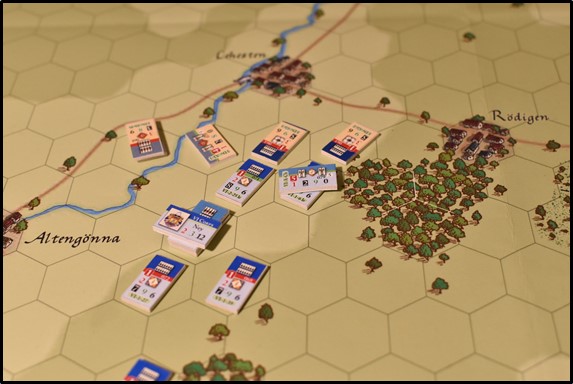
VIth Corps attacks the infantry of Holtzendorf’s detachment
The Prussian guns in the centre began to find their range and disorganized the French VIIth Corps’ 1st Artillery. There were many more French guns in the line than Prussian, as Prussian artillery were lagging behind their rapidly advancing infantry. In the centre, the unfortunate Prussian 5th Infantry received the most accurate of the French gunnery. In the east, the combined guns and infantry fire of VIth Corps severely weakened the 1st Grenadiers just as the French 25th Infantry launched an assault. The shocked grenadiers fell back to the village of Lehesten under the relentless onslaught. Adjacent to the 1st Grenadiers, the 2nd were more successful against the advancing 6th Light Infantry and in the ensuing melee both caused significant losses but neither gave ground.
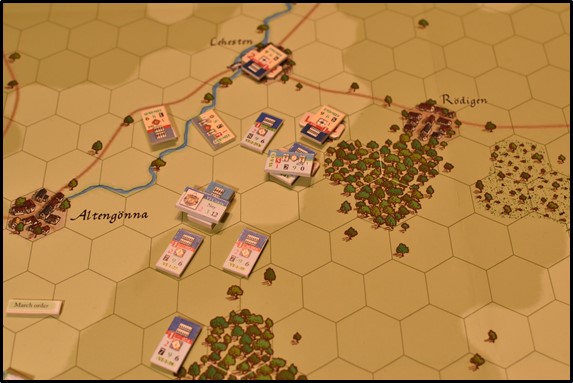
The fighting west of Rodigen remained fierce but the French had more forces arriving…
With the exception of Murat’s cavalry, the French forces were now nearly fully deployed. The question Hohenlohe was asking himself, ‘Would Napoleon allow his men a brief respite before launching his inevitable attack?’ All the French units were now in good order and awaiting orders from the Emperor.
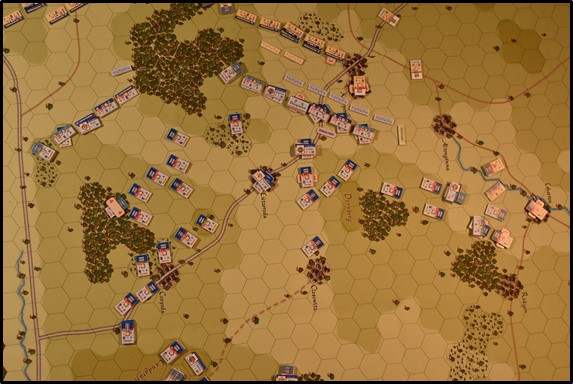
The French army was now almost fully deployed
Ney gained two additional fatigue for his movement and melee on the grenadiers. Lannes Vth Corps recovered a single fatigue and the rest of the French corps all gained fatigue (the Prussian guns were ensuring that Lannes’ Corps received regular fire to slow down its fatigue recovery).
10:00 Prussian turn
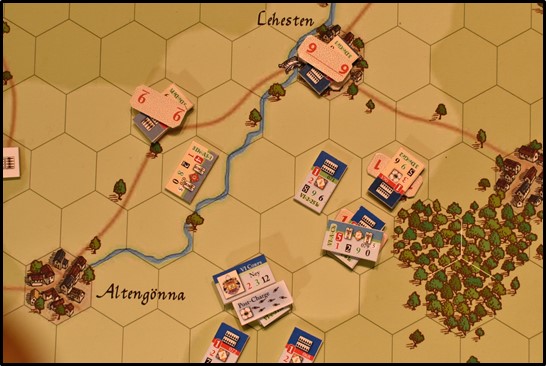
The Prussian horse artillery pulled back over the stream to cover their broken cavalry but quickly unlimbered to offer some support to the grenadiers still facing enemy infantry.
On the Prussian left flank, the cavalry who had withdrawn from the advancing French infantry, turned around and launched their own charge against the French horse. Under Ney’s leadership the French cavalry had no trouble wheeling around and counter-charging the Prussians. The Prussian charge was a disaster, the ground around the stream proved softer and marshier then they expected and it sapped the strength of the horses and when they joined with the French cavalry they were easily repulsed. The Prussian horse artillery who witness the cavalry’s reverse quickly limbered and with some difficulty crossed the stream and unlimbered to try and aid the stricken Prussian grenadiers who were now abandoned by their cavalry and artillery.
Ruchel decided not to launch his attack yet, as he was still awaiting the arrival of his artillery. Just after 10am the artillery began to arrive and the 1st artillery unlimbered, with the 2nd just a little further behind.
In the centre, the 1st division was in position but it would be another hour before the 2nd division was so.
French guns opened fire all over the front, causing hits to Prussian infantry and artillery (using the optional artillery rule ½ losses). Prussian gun’s firing on the flank of the 25th Light Infantry caused consternation amongst the ranks and the infantry fell back disorganised. Ney was reported to have been visibly appalled by the performance of that unit.
Holtzendorf’s 3rd Grenadiers having no option but to press an attack, launched themselves at the 16th Light Infantry and their supporting guns. The grenadiers managed to take out several guns but at a high cost to themselves, again neither side manged to gain a decisive advantage.
At the clock indicated 10:30 the last remaining patches of fog finally lifted…
The battle at 10:30
With the open moves in the fog now completed the battle proper was about to begin. Neither side had gained an obvious substantial advantage in the initial stage of the battle.
Napoleon’s army was suffering from greater fatigue than Hohenlohe’s although the French’s greater initial average morale made this less of an issue than the Prussian would have hoped for. The fatigue for each formation was as follows:

Vth Corps (Lannes): 7 (-1 morale penalty)
IVth Corps (Soult): 8 (-1 morale penalty)
VIth Corps (Ney): 8 (-1 morale penalty)
VIIth Corps (Augereau): 6 (-1 morale penalty)
Cavalry Corps (Murat): 2
In terms of losses the situation at 10:30 was this:
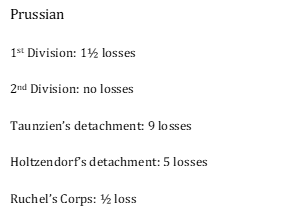
French
Guard (Lefebvre): no losses.
Vth Corps (Lannes): 15½ steps
IVth Corps (Soult): no losses
VIth Corps (Ney): 2½ losses
VIIth Corps (Augereau): no losses
Cavalry Corps (Murat): no losses
Total losses: 18 step losses
7 steps disorganized
Hohenlohe had adopted an aggressive strategy with 1st, 2nd Division & Ruchel’s forces all having attack orders. This was not because he thought he could ‘win’ the battle but believed if he could catch the French when they were fatigued, after their long marches, he may be able to disrupt their plans. Additionally, the French artillery was superior and the Prussians would soon get the worst of any extended artillery exchange. The Prussian plan at 10:30 remained to undertake a short assault all along the line, then coordinate a fighting withdrawal back towards their lines of communications. The first victory hurdle for Hohenlohe was to survive until just after 3pm, that would rob Napoleon of a grand victory.
Napoleon at 10:30 was quietly satisfied with his army’s progress. His plan was simple: hold the centre and on the French left, Soult was to engage Ruchel along the Weimar-Jena road and push him back and threaten to cut off the main Prussian force from Weimar. When Hohenlohe sends forces to reinforce his right the centre would advance. On the French right, Murat would use his cavalry to harry the Prussian redeployment. The plan was sound the only issue was would the Prussians army morale break in time for Napoleon to enjoy a crushing victory?
As the fog cleared, Hohenlohe could finally see the magnitude of the French forces arrayed before him, but all he needed to do was to hang on long enough…
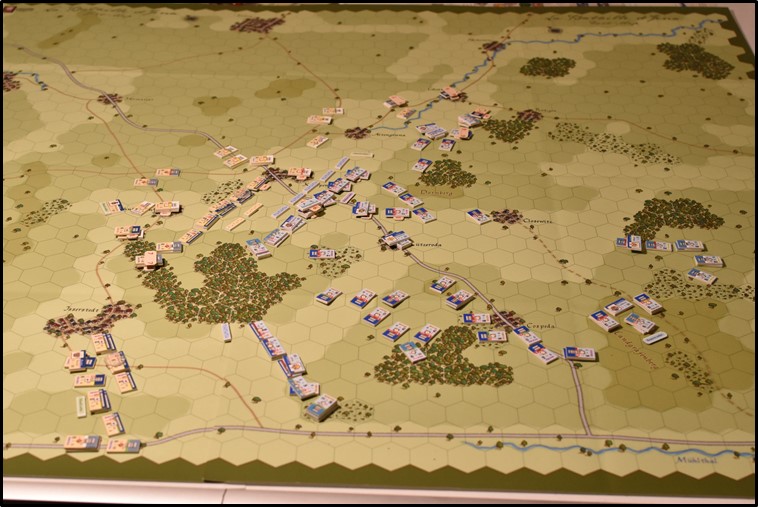
The battle at approximately 10:30.
